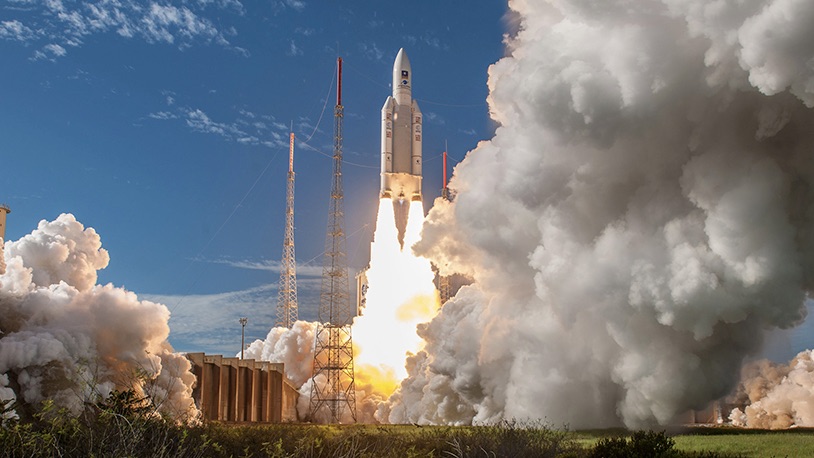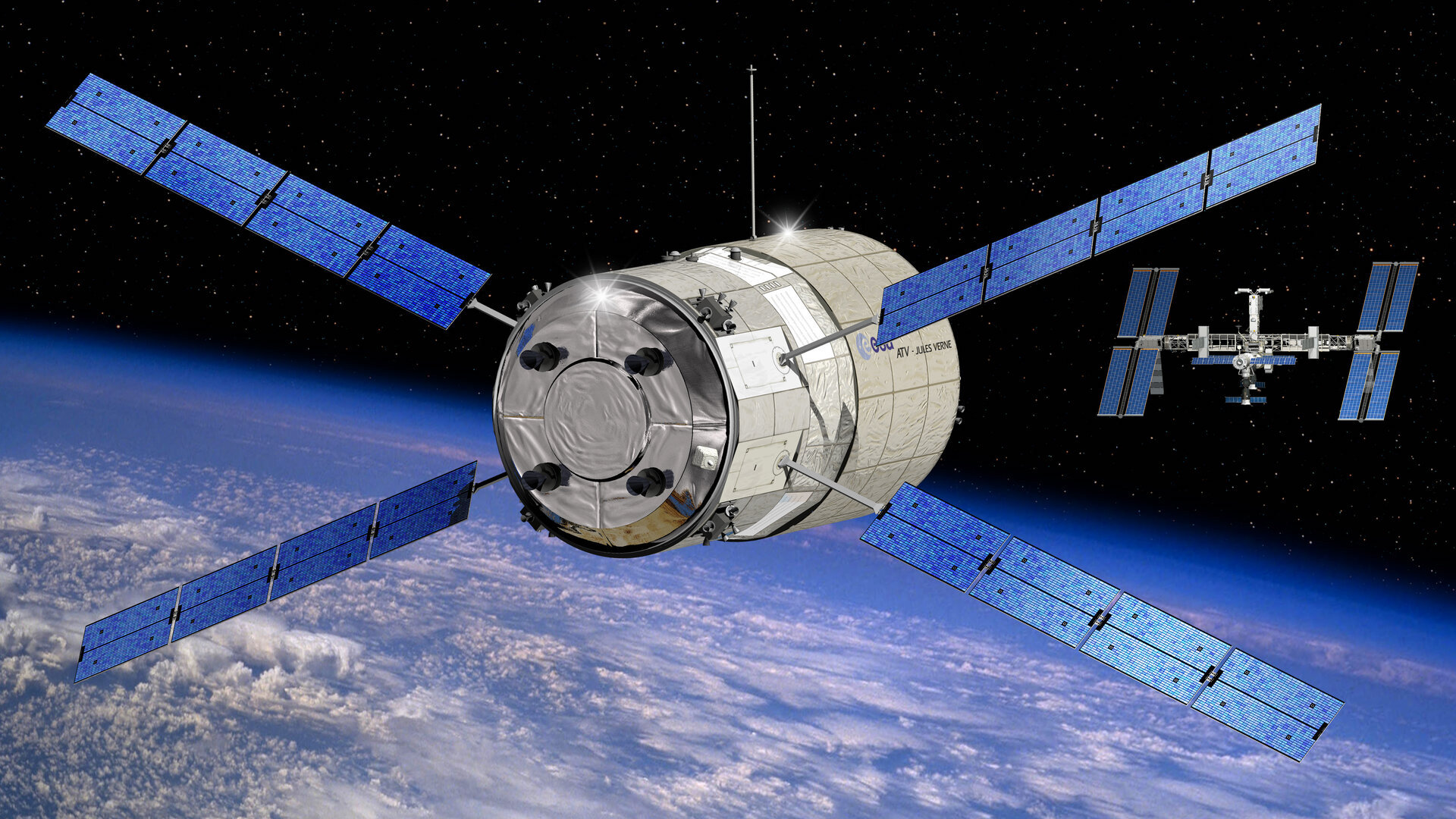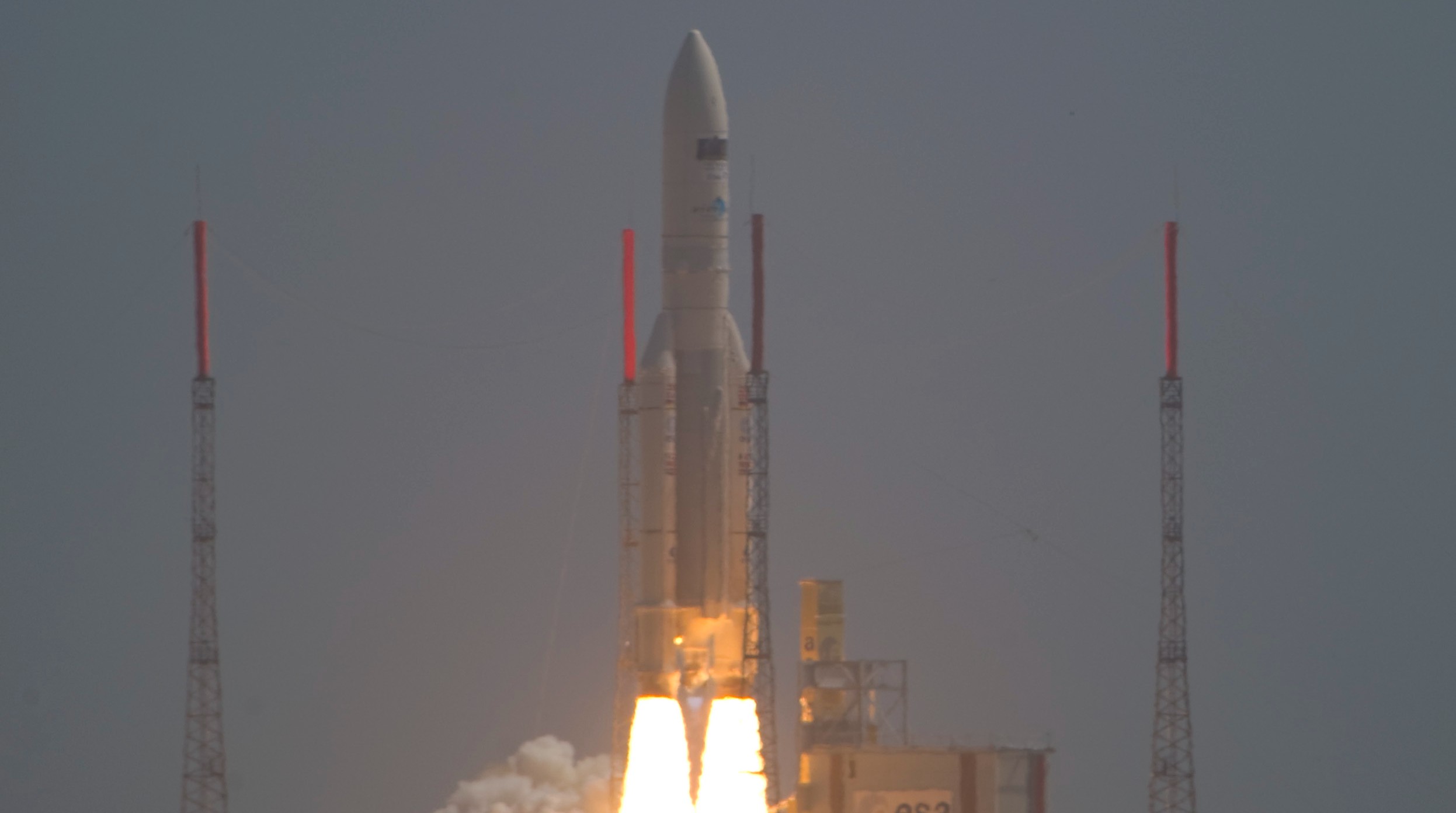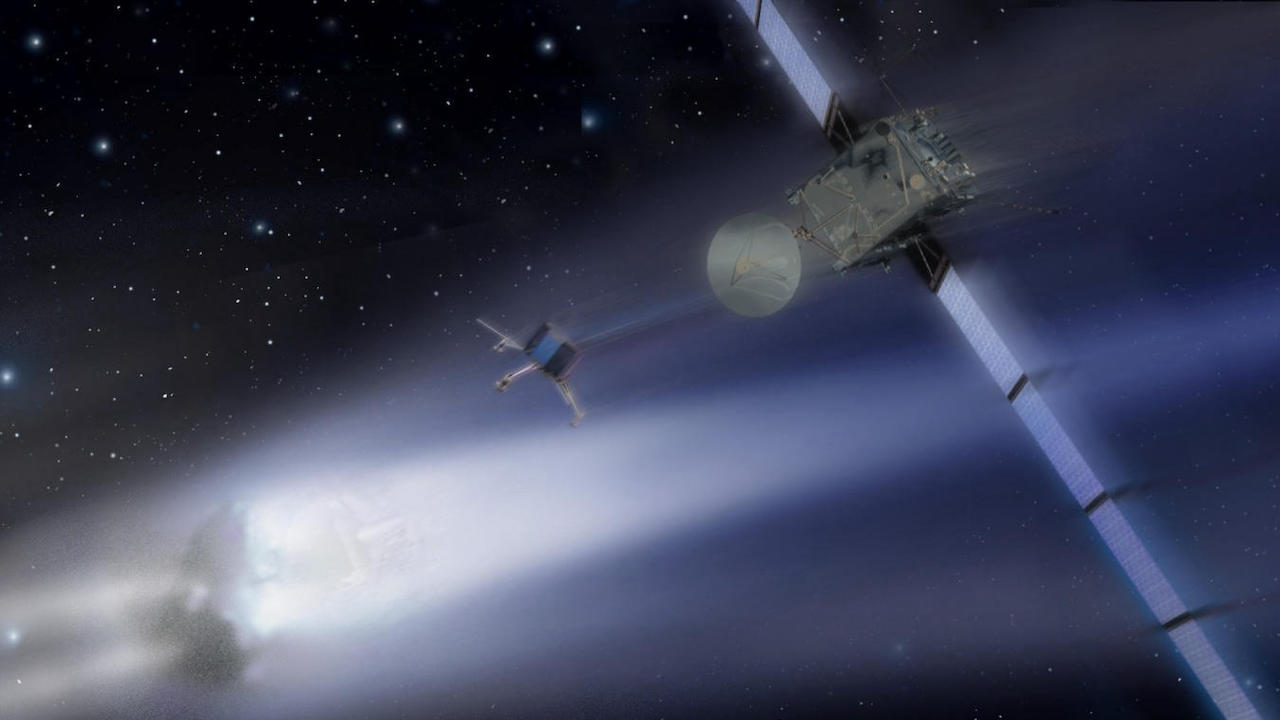The top 10 Ariane 5 rocket launches of all time
Revisit some of the mighty, soon-to-be-retired European rocket's most memorable liftoffs.
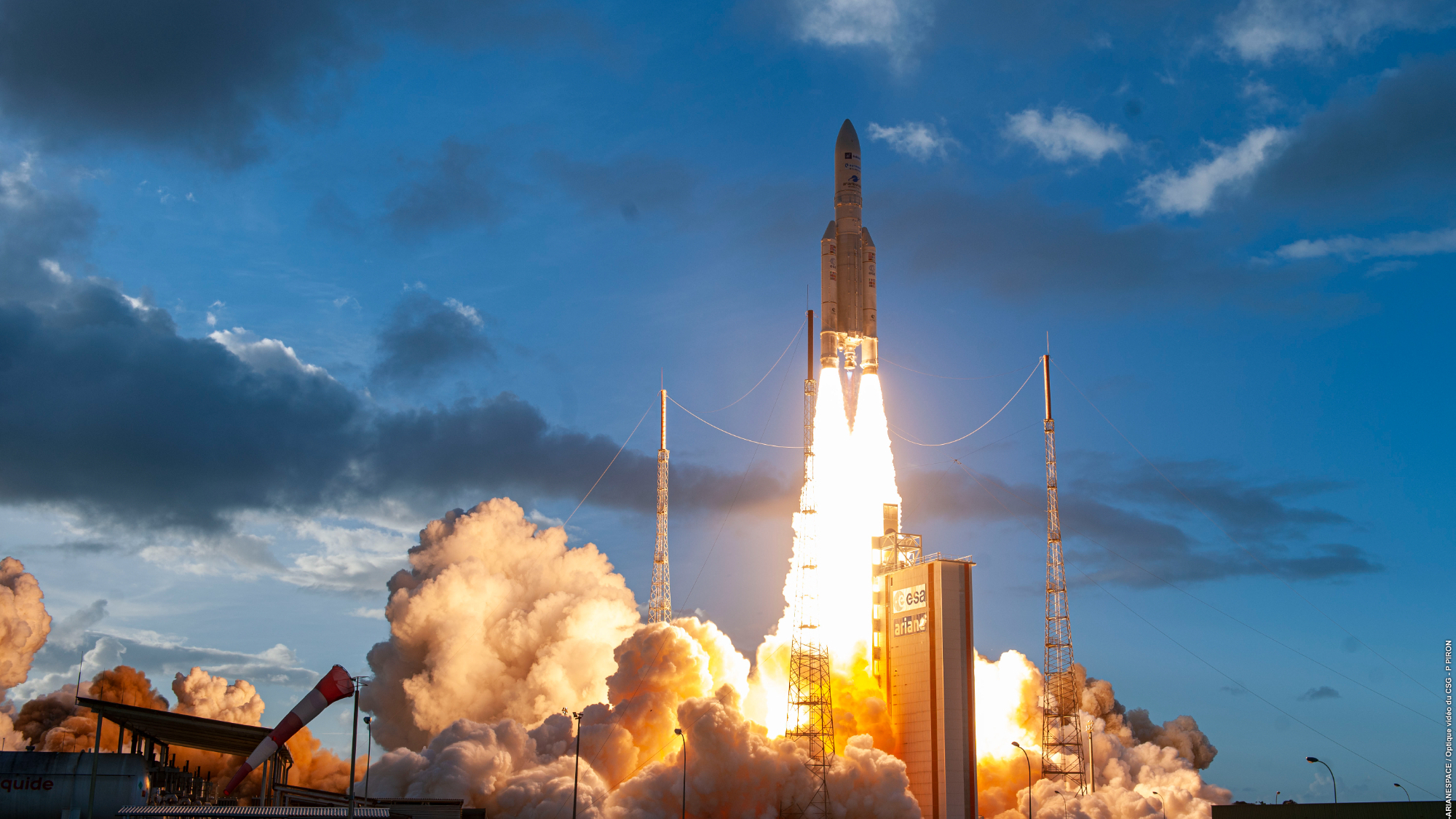
The Ariane rocket family has a storied history that dates back to the 1970s. Commissioned by the European and French space agencies (ESA and CNES, respectively), the family's fifth-generation launch vehicle, the Ariane 5, was developed and manufactured by Arianespace and began flying in 1996. Ariane 5 has stood as Europe's workhorse rocket for decades now, longer than any of its Ariane predecessors, and has more than 100 missions under its belt.
But that impressive run is about to end. There's just one Ariane 5 mission left — a flight called VA261 that's scheduled to launch from Europe's Spaceport in French Guiana on Tuesday (July 4) after a delay. VA261 will loft an experimental communications satellite called Heinrich Hertz for the German space agency and Syracuse 4b, a French communications satellite. (Ariane 5's replacement, the Ariane 6, is not yet ready to fly, by the way. It was originally expected to debut in 2020, but a series of setbacks have pushed that target to late 2023 at the earliest.)
While a couple of communication satellites may not make front-page news, the Ariane 5 has had some extremely notable launches during its run. So, as we prepare to bid the final Ariane 5 adieu, here is a look at the rocket's top 10 missions.
Related: Facts about the Ariane 5, Europe's workhorse rocket
10, 9, and 8 — Galileo navigation-satellite launches
The Galileo constellation is the backbone of Europe's satellite-navigation capabilities. Its utility to European citizens and governments is intertwined with numerous aspects of everyday life and is crucial to the continent's defense and infrastructure.
Twelve of the 24 currently operable Galileo satellites were launched on Ariane 5 rockets, which are able to loft four of the hefty spacecraft to orbit at a time — a significant increase over the constellation's previous cadence of two-per-launch aboard Russian-built Soyuz rockets. Ariane 5's three Galileo missions launched in November 2016, December 2017 and July 2018.
7 — ATV Jules Verne
ESA's first Automated Transfer Vehicle (ATV), the Jules Verne, launched atop an Ariane 5 on March 8, 2008. The ATV was designed for cargo missions to the International Space Station (ISS) and was capable of carrying over 7 tons of supplies and experiments for the station and its crew.
Breaking space news, the latest updates on rocket launches, skywatching events and more!
At the time, the collective 20-ton mass of the ATV Jules Verne was more than double the maximum weight ever launched by an Ariane 5 rocket. To accommodate this heavy load, the launch vehicle and its infrastructure underwent a set of upgrades, including the addition of structural supports to the Ariane 5's Vehicle Equipment Bay.
Five ATV spacecraft visited the ISS between 2008 and 2015, when the cargo-ship program came to an end. All five launched aboard the Ariane 5.
6 — XMM-Newton
ESA's X-ray Multi-Mirror Mission (XMM-Newton) launched on an Ariane 5 on Dec. 10, 1999 and is still going strong. Instead of one X-ray telescope, XXM-Newton is actually three. The satellite contains a trio of advanced X-ray imaging devices, each made with 58 tiny, cylindrical mirrors all housed within one another and used to increase the telescope's field of view. These work alongside a spectrometer and other cameras that allow mission team members to study distant galaxy clusters, pulsars, black holes and other enigmatic space phenomena.
5 — BepiColombo
An Ariane 5 launched the BepiColombo mission for ESA and the Japanese space agency (JAXA) on Oct. 20, 2018. BepiColombo is headed where few spacecraft have gone before — the planet Mercury. The double-orbiter probe consists of the European Mercury Planetary Orbiter and the Japanese Mercury Magnetospheric Orbiter. The two are on a journey to reach orbit around Mercury, which has only been accomplished by one other spacecraft, NASA's MESSENGER probe.
To get there, BepiColombo is taking the scenic route. As space missions go, getting into orbit around Mercury is harder than reaching Pluto. The increasing gravity from the sun as you fly deeper into the inner solar system makes capture by a small, fast-orbiting planet like Mercury extremely difficult.
To overcome this obstacle, BepiColombo is using the gravity of multiple planets to slow the spacecraft's velocity. In the five years since its launch, BepiColombo has performed two Venus flyby maneuvers and a flyby of Earth, which occurred in April 2020. And it will take a total of six passes of Mercury before the spacecraft can be captured by the planet's weak gravitational pull. BepiColombo completed its third flyby of Mercury on June 12 and is expected to finally reach orbit around the planet in 2025.
4 — Herschel Space Observatory and Planck probe
The Herschel Space Observatory and Planck probe were a powerhouse duo that launched on an Ariane 5 on May 14, 2009. Parked at the Earth-Sun Lagrange Point 2 (L2), a gravitationally stable spot about 1 million miles (1.5 million kilometers) from Earth, Herschel and Planck remained in operation from 2009 until June 2013 and October 2013, respectively. Both spacecraft more than lived up to their mission expectations.
Both were built and operated by ESA. At the time, Herschel was the largest infrared telescope to ever launch, and was only recently dethroned by another well-known space telescope that also launched on an Ariane 5 (which you can read about a bit further down this list). Herschel was outfitted with the largest mirror ever sent to space at the time, and its mission propelled research into the early universe, star formation, and the atmospheres of planets and moons in our own solar system.
Planck was designed to study the cosmic microwave background (CMB), radiation associated with the Big Bang and early universe. Planck's highly sensitive instruments allowed the probe to take unprecedented CMB measurements, which scientists used to help determine the age of the universe and produce the first CMB map of the entire sky.
Related: Planck probe sees Big Bang relics (gallery)
3 — Rosetta
ESA's Rosetta mission was an enormous undertaking that resulted in some major firsts for space exploration. Launched on an Ariane 5 on March 2, 2004, Rosetta and its lander Philae spent 10 years catching up to Comet 67P/Churyumov-Gerasimenko (also known as 67P). On Aug. 6, 2014, Rosetta became the first spacecraft ever to orbit a comet, beaming back extraordinary views of the icy body in unparalleled detail.
On Nov. 12 of that year, the Philae lander detached from Rosetta to attempt the first-ever landing on a comet's surface. Not all parts of Philae's landing went as planned: Anchoring harpoons designed to latch onto the comet during touchdown failed to fire, causing the spacecraft to bounce twice before settling on the surface. When Philae did come down for good, a cliff kept the lander in almost permanent shadow, obscuring the probe's solar panels from the sun.
Rosetta lost contact with Philae three days later, preventing the lander from meeting the majority of its mission objectives. But Rosetta remained in orbit around 67P for two more years, conducting studies of the comet's nucleus and changes caused by its varying proximity to the sun. In July 2015, 67P was positioned just right for some sunlight to reach Philae, and the lander momentarily woke up. Philae made contact with the Rosetta orbiter a few times during that short span before shutting off for a final time.
On Sept. 30, 2016, with its pioneering mission at an end, Rosetta aimed itself toward 67P and performed a kamikaze dive into the comet's frigid surface.
Related: Europe's Rosetta comet mission in photos
2 — JUICE
The Jupiter Icy Moons Explorer (JUICE) is another ESA mission that is going to make some serious waves. JUICE was Ariane 5's penultimate mission, launching on April 14 of this year, and is now on a 7.5-year journey to the Jovian system. To get there, the spacecraft will perform three gravity-assist flybys of Earth and one of Venus, before finally arriving at Jupiter in December 2031. When it gets there, JUICE will orbit the planet for three years, making close flybys of three of Jupiter's icy ocean moons and studying them for signs of habitable conditions.
JUICE will perform two passes of Europa, one of the solar system's best bets for alien life, several passes of Callisto, Jupiter's second-largest moon and one of the solar system's most ancient planetary bodies, and finally Ganymede, the largest moon in our solar system and JUICE's primary target. The probe will pass Ganymede a dozen times before nestling into orbit around the moon in 2034. When it does that, JUICE will become the first spacecraft to orbit a planetary moon other than that of Earth.
Ganymede is larger than the planet Mercury and is the only moon in the solar system that produces its own magnetic field. Using nearly a dozen scientific instruments, JUICE will study Ganymede's complex inner core, analyze the moon's surface and collect data on the potential for its icy environment to sustain life.
1 — James Webb Space Telescope
Are you surprised? Granted, this list is entirely subjective, but who isn't putting this famous scope in the top spot? NASA's James Webb Space Telescope (JWST) is the largest and most powerful off-Earth observatory ever launched. This miraculous feat of science and engineering li on an Ariane 5 rocket on Dec. 25, 2021.
A massive, multi-layered sunshield, measuring nearly 70 feet by 50 feet (22 by 15 meters), protects the telescope's 18-segment primary mirror, which is approximately 21 feet (6.5 m) across. Like its infrared telescope predecessor Herschel (mentioned above), JWST is parked at L2, in the darkness of space a million miles from Earth.
Part of JWST's mission involves peering back into deep time, to see the universe's first light. The telescope has detected hundreds of early galaxies, helped characterize exoplanets, revealed marvelous hidden features of star clusters and nebulae thousands of light-years away and provided some of the most detailed views to date of planets in our own solar system, like this image of Uranus, released earlier this year. JWST is only in the beginning of its research, and it's expected to keep studying the cosmos for over a decade.

Josh Dinner is the Staff Writer for Spaceflight at Space.com. He is a writer and photographer with a passion for science and space exploration, and has been working the space beat since 2016. Josh has covered the evolution of NASA's commercial spaceflight partnerships and crewed missions from the Space Coast, as well as NASA science missions and more. He also enjoys building 1:144-scale model rockets and human-flown spacecraft. Find some of Josh's launch photography on Instagram and his website, and follow him on X, where he mostly posts in haiku.
